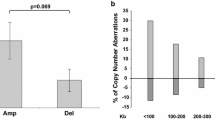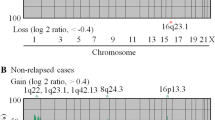Abstract
Currently there is a lack of objective markers that can reliably differentiate benign and malignant follicular thyroid tumours. Such markers are needed to avoid the morbidity and cost of diagnosing these lesions by a thyroid lobectomy and then a second operation to remove the remaining half of thyroid if cancer is found. The aim of this research was to look for genomic markers that might solve this important problem. Ethical approval for the project was obtained. DNA was extracted from formalin-fixed paraffin-embedded specimens and copy number analysed using an in-house produced 1-megabase genomic array by comparative genomic hybridization (1Mb-aCGH). Acceptable quality data were obtained in 25/26 (96 %) of adenomas and 17/28 (61 %) of carcinomas. Among the carcinomas, 11 were minimally invasive (MI), 5 widely invasive (WI) and there was one metastasis. Recurrent copy number changes distinguishing benign and malignant included +1p34.2–36.33, +1q, +13q12.11–14.3, +14q22.1–32.33, +20q and −22. +20q became more sensitive (36.4 %) for MI carcinomas, whereas +13q12.11–14.3 and +14q22.1–32.33 became more sensitive (66.7 %) for identifying WI cancers from adenomas. Only in the context of aneuploidy (3 adenomas, 3 MI, 3 WI) there were some specific copy number changes that could differentiate all aneuploid adenomas from carcinomas. This research is the first using 1Mb-aCGH to study benign and malignant follicular thyroid tumours. Overall, the incidence of any copy number changes is low, but there are a number of changes associated with different tumour types. Further research with a larger sample and better quality DNA will clarify these findings.








Similar content being viewed by others
References
Schmutzler C, Koehrle J (2000) Innovative strategies for the treatment of thyroid cancer. Eur J Endocrinol 143:15–24
BTA R (2007) Guidelines for the management of thyroid cancer, 2nd edn. British Thyroid Association and The Royal College of Physicians, London
Liska J, Altanerova V, Galbavy S, Stvrtina S, Brtko J (2005) Thyroid tumors: histological classification and genetic factors involved in the development of thyroid cancer. Endocr Regul 39:73–83
Monson JP (2000) The epidemiology of endocrine tumours. Endocr Relat Cancer 7:29–36
Shaha AR (2005) Advances in the management of thyroid cancer. Int J Surg 3:213–220
Suen KC (2002) Fine-needle aspiration biopsy of the thyroid. CMAJ 167(5):491–495
Lin JD, Chao TC (2006) Follicular thyroid carcinoma: from diagnosis to treatment. Endocr J 53:441–448
Delbridge L, Lean CL, Russell P et al (1994) Proton magnetic resonance and human thyroid neoplasia. II: potential avoidance of surgery for benign follicular neoplasms. World J Surg 18:512–516 (discussion 516–517)
King AD, Yeung DK, Ahuja AT et al (2005) In vivo 1H MR spectroscopy of thyroid carcinoma. Eur J Radiol 54:112–117
Suster S (2006) Thyroid tumors with a follicular growth pattern: problems in differential diagnosis. Arch Pathol Lab Med 130:984–988
Lin JD (1988) Poor prognosis of 56 follicular thyroid carcinomas with distant metastases at the time of diagnosis. J Cancer 11:190–195
Johnson NA, Hamoudi RA, Ichimura K et al (2006) Application of array CGH on archival formalin-fixed paraffin-embedded tissues including small numbers of microdissected cells. Lab Invest 86:968–978
Cooper DSea (2009) Revised American Thyroid Association management guidelines for patients with thyroid nodules and differentiated thyroid cancer. Thyroid 19:1167–1214
Sadler PG, Watkinson JC, Perros Petros, Harrison B (2011) Thyroid cancer. In: Head and neck cancer: multidisciplinary management guidelines, 4th edn. ENT UK, London, pp 241–255
Frisk T, Kytola S, Wallin G, Zedenius J, Larsson C (1999) Low frequency of numerical chromosomal aberrations in follicular thyroid tumors detected by comparative genomic hybridization. Genes Chromosomes Cancer 25:349–353
Roque L, Rodrigues R, Pinto A, Moura-Nunes V, Soares J (2003) Chromosome imbalances in thyroid follicular neoplasms: a comparison between follicular adenomas and carcinomas. Genes Chromosomes Cancer 36:292–302
Criado B, Barros A, Suijkerbuijk RF et al (1995) Detection of numerical alterations for chromosomes 7 and 12 in benign thyroid lesions by in situ hybridization histological implications. Am J Pathol 147:136–144
Roque L, Serpa A, Clode A, Castedo S, Soares J (1999) Significance of trisomy 7 and 12 in thyroid lesions with follicular differentiation: a cytogenetic and in situ hybridization study. Lab Invest 79:369–378
Ciampi R, Zhu Z, Nikiforov YE (2005) BRAF copy number gains in thyroid tumors detected by fluorescence in situ hybridization. Endocr Pathol 16:99–105
Hemmer S, Wasenius VM, Knuutila S, Franssila K, Joensuu H (1999) DNA copy number changes in thyroid carcinoma. Am J Pathol 154:1539–1547
Jacob AN, Kandpal G, Kandpal RP (1996) Isolation of expressed sequences that include a gene for familial breast cancer (BRCA2) and other novel transcripts from a five megabase region on chromosome 13q12. Oncogene 13:213–221
Hemmer S, Wasenius VM, Knuutila S, Joensuu H, Franssila K (1998) Comparison of benign and malignant follicular thyroid tumours by comparative genomic hybridization. Br J Cancer 78:1012–1017
Torres EM, Williams BR, Amon A (2008) Aneuploidy: cells losing their balance. Genetics 179:737–746
Joensuu H, Klemi PJ (1988) Comparison of nuclear DNA content in primary and metastatic differentiated thyroid carcinoma. Am J Clin Pathol 89:35–40
Joensuu H, Klemi PJ, Eerola E (1987) Diagnostic value of flow cytometric DNA determination combined with fine needle aspiration biopsy in thyroid tumors. Anal Quant Cytol Histol 9:328–334
Schelfhout LJ, Cornelisse CJ, Goslings BM et al (1990) Frequency and degree of aneuploidy in benign and malignant thyroid neoplasms. Int J Cancer 45:16–20
Missaoui N, Hmissa S, Mokni M et al (2005) DNA content analysis in thyroid neoplasms: diagnostic and prognostic interest. Ann Endocrinol (Paris) 66:333–339
Cusick EL, Ewen SW, Krukowski ZH, Matheson NA (1991) DNA aneuploidy in follicular thyroid neoplasia. Br J Surg 78:94–96
Harlow SP, Duda RB, Bauer KD (1992) Diagnostic utility of DNA content flow cytometry in follicular neoplasms of the thyroid. J Surg Oncol 50:1–6
Oyama T, Vickery AL Jr, Preffer FI, Colvin RB (1994) A comparative study of flow cytometry and histopathologic findings in thyroid follicular carcinomas and adenomas. Hum Pathol 25:271–275
Gudmundsson J, Sulem P, Gudbjartsson DF et al (2009) Common variants on 9q22.33 and 14q13.3 predispose to thyroid cancer in European populations. Nat Genet 41:460–464
Acknowledgments
S. B. Coghill BMedSc, MBBCh, FRCPath (Consultant Histopathologist and Cytologist) for categorising tumour specimens. K. Ichimura MBBS, PhD (Senior Research Associate) for laboratory assistance and proofreading the data. Eastern Cancer Registration and Information Centre (Cambridge, UK) for providing access to their database to identify appropriate tumour cases.
Conflict of interest
The authors declare that they have no conflict of interest.
Author information
Authors and Affiliations
Corresponding author
Rights and permissions
About this article
Cite this article
Qureshi, A.A., Collins, V.P. & Jani, P. Genomic differences in benign and malignant follicular thyroid tumours using 1-Mb array-comparative genomic hybridisation. Eur Arch Otorhinolaryngol 270, 325–335 (2013). https://doi.org/10.1007/s00405-012-2017-4
Received:
Accepted:
Published:
Issue Date:
DOI: https://doi.org/10.1007/s00405-012-2017-4




